Northamptonshire
Explore hidden histories, historic photos, and things you never knew about Northamptonshire from the collections and archives of Historic England.
Discover your local listed buildings and places
Introducing some of Northamptonshire's most historic sites, included in the National Heritage List for England. Some of these captions have been summarised by AI. Click through for the official List entry. Skip this section and go to place by numbers
Drayton House
Lowick
Drayton House features formal gardens from around 1700 with contributions from Tilleman Bobart, John Van Nost, and Henry Wise, set within a historic landscape park.
Drayton House
Lowick
Drayton House, a Grade I listed country house, features significant architectural evolutions from the late 13th to early 20th centuries, showcasing works by notable figures like Isaac Rowe...
Church of St Giles
Northampton
The Church of St Giles, dating back to the 12th century, features significant historical architecture, including a C12 crossing tower, C14 chapels, and a C15 nave.
Kettering Railway Station, including the main building an…
Kettering
Kettering station, including the main building and platforms 1,2,3 and 4 and their associated buildings and canopies, constructed in 1857 to the designs of C H Driver, expanded in 1879, and...
Thor missile site at former RAF Harrington including the …
Draughton
A Thor missile satellite base established at the former World War II airfield of RAF Harrington, constructed in 1959 and operational until 1963. Partially cleared in the late C20.
Easton Neston
Easton Neston
Easton Neston, a notable 17th-century country house in Northampton, features gardens designed by Sir Christopher Wren and Nicholas Hawksmoor, surrounded by a historically rich park.
Abandoned Medieval Village of Little Oxendon
Great Oxendon
Remains of the medieval village of Little Oxendon and associated ridge and furrow. Read the official list entry to find out more.
Muscott deserted medieval village and double moated site
Norton
Muscott deserted medieval village and moated site offers well-preserved archaeological evidence of medieval settlement, reflecting economic and social patterns, with extensive roadways and...
Boughton Hall
Boughton
Boughton Hall features early 18th-century gardens and a park designed by William Wentworth, featuring gothic follies and landscaping, once admired by Horace Walpole for its taste.
Wakefield Lodge Park
Deanshanger
Landscape park designed by Lancelot 'Capability' Brown in the mid-C18. Read the official list entry to find out more.
Battle of Northampton 1460
Far Cotton and Delapre
Battlefield, site of the Battle of Northampton, 10th July 1460. Read the official list entry to find out more.
Former Northampton Union Workhouse
Northampton
Former Northampton Union Workhouse built 1836-7 to the designs of George Gilbert Scott, with later C19 additions. Read the official list entry to find out more.
Rushton Hall
Rushton
Rushton Hall showcases 20th-century gardens by Thomas Mawson and 16th-century features. The estate has a rich history, linked to figures like Sir Thomas Tresham.
Church of the Holy Sepulchre
Northampton
The Church of the Holy Sepulchre is a rare round church with a circular nave based on Jerusalem's church, notable for its historical and architectural evolution since circa 1100.
Roman town of Irchester and preceding Iron Age settlement…
Irchester
A small Roman town and its suburbs, occupied between the C1 and early C5 AD, its preceding Iron Age settlement, and the medieval hamlet of Chester on the Water, abandoned by the early C18.
Mounts Baths
Northampton
Public swimming baths, built 1935-6 to the designs of J. C. Prestwich & Sons. The engineers were Sir Alexander Gibb & Partners. Read the official list entry to find out more.
Church of All Saints
Brixworth
The Church of All Saints in Brixworth, constructed in the 7th, 10th, 13th, and 19th centuries, features Roman tiles, a C7 round-headed arcade, and a C14 broach spire.
Aynho Park
Aynho
Aynho Park is a historic 17th-century country house, extensively remodeled over the centuries, with landscape work by notable designers Lancelot Brown and Humphry Repton.
Castle Ashby
Castle Ashby
Summary of Importance: Castle Ashby has notable formal gardens, enhanced by Lancelot Brown in the 1760s.
Former Memorial Hall, Castilian Street, Northampton
Northampton
Memorial Hall. Erected in 1921 by Alexander Ellis Anderson. Read the official list entry to find out more.
Sessions House
Northampton
Sessions House, built between 1676-1678 after the town fire of 1675, features a symmetrical Corinthian front and interior plaster ceilings by Edward Goudge.
Judge's Lodgings
Northampton
Judge's Lodgings, adjoining Sessions House, is an 18th-century building with a notable ashlar front and central doorway, contributing to a historic architectural group.
Knuston Hall Including Attached Outbuildings
Irchester
Country house and outbuildings, now residential College of Adult Education. Read the official list entry to find out more.
Canons Ashby
Canons Ashby
Canons Ashby features formal 1710 terraced gardens, associated with a late 16th to 17th-century country house, once owned by the Dryden family and poet Edmund Spenser.
Harrington
Harrington
Harrington's earthwork remains include formal gardens and medieval fishponds linked to historical ownership by the Order of St John and the Stanhopes.
Mallows Cotton deserted medieval village
Raunds
Mallows Cotton, a deserted medieval village, offers extensive earthworks and archaeological deposits.
Church of the Holy Trinity
Northampton
The Church of the Holy Trinity in Northampton, designed by Matthew Holding in 1909, exhibits Perpendicular style with a notable south transeptal tower and timber roof.
Brockhall Park
Brockhall
Brockhall Park, created around 1800 with John Webb's advice, replaced earlier gardens from the 1720s.
Apethorpe Palace Formerly Known As Apethorpe Hall
Apethorpe
Apethorpe Palace, originally built in the late 15th century by Sir Guy Wolston, features Elizabethan, Jacobean, and Palladian styles.
The Royal George Public House
Cottingham
A former open hall house at the Royal George in Cottingham, dated by dendrochronology to 1262, with later alterations and additions, including the insertion of the first floor in the early...
Wicksteed Park
Barton Seagrave
Wicksteed Park, opened in 1921, is a significant early 20th-century amusement park in Kettering, designed by Charles Wicksteed, featuring extensive playground equipment and a large lake.
Church of St Katherine
Irchester
Church of St Katherine, a Grade I listed building, features late 12th to 14th-century architecture with Perpendicular windows, medieval stained glass fragments, and notable monuments.
Aynhoe Park
Aynho
Aynhoe Park is a historic country house turned flats, originally from the early 17th century and remodeled multiple times, notably by Edward Marshall, Thomas Archer, and Sir John Soane.
Barnwell, St Andrew's Manor
Barnwell
Barnwell St Andrew features historic gardens from c 1920 and a 1613 raised walk, originally associated with a castle and house dating back to the 12th century.
Wellingborough Railway Station
Wellingborough
Main station building and canopy to platform 1 of 1857 by Charles Henry Driver for the Midland Railway, with later additions. Platforms 2 and 3 share a building and canopy of 1894.
Althorp
Althorp
Althorp is a historic estate associated with the Spencer family. It features gardens, a park with mature trees, and buildings reflecting developments from the 16th to the 20th century.
Lamport Hall
Lamport
John Isham bought the manor of Lamport in 1560, leading to significant developments by his descendants, including gardens and architectural expansions through the 17th to 19th centuries.
Horton Hall Park
Hackleton
Landscape park laid out mainly in the mid-C18, designed by Thomas Wright as the setting for a country house (demolished 1930s), with the earthwork remains of an early-C18 landscape scheme...
Explore more
Search for more listed placesNorthamptonshire through time
This timeline shows the first period of use for buildings and places on the National Heritage List for England, just one of the details recorded for every list entry. Click around to see how Northamptonshire changes over time. Skip this section and go to aerial photos
Prehistoric Before AD 43
Prehistory covers a million years of human occupation before the Roman invasion and the introduction of writing. Primarily hunter-gatherers of several human species including Neanderthals, the peoples moved across Europe, hunting animals, exchanging ideas and developing complex culture and belief systems including burial rites and astronomical understanding, as at Stonehenge for example.
Roman AD 43 to AD 410
Britain was invaded by four legions of the Roman army in AD 43, who relatively rapidly conquered England from landing points in Kent. Parts of Wales and Scotland soon followed.
Roman culture brought urbanism, monumental buildings, wide-ranging religious beliefs, writing, and strong social hierarchy. The Roman administrative system was withdrawn in AD 410.
Early medieval AD 410 to AD 1066
This period, often associated in England with Anglo-Saxons and Vikings, saw a reduction in urban living from the Roman period and increased migration from northern Europe.
Traces of this period can be found in cemeteries, particularly in artefacts and in some of the very early churches, as this period also saw the growth of Christianity in Britain.
Medieval AD 1066 to AD 1540
This period, sometimes known as the Middle Ages, began with the Norman invasion in AD 1066. It saw a significant rise in military and defensive buildings such as castles and earthworks, as well as religious houses dominating a largely agricultural landscape.
The monarchy and Church dominated the period, which also saw the break with the Roman Catholic Church and the English reformation.
Post medieval AD 1540 to AD 1901
The Post-Medieval period brought seismic changes to life in England, with religious reformation leading to the democratization of worship and the destruction of hundreds of religious houses.
In parallel, there was a huge expansion of scientific study and enlightenment that permanently altered the nation's social structure and landscape. Industrialization and mass production lead to wider global trade, emigration, and immigration.
20th century AD 1901 to AD 2000
The 20th century saw an incredible expansion of England's transport networks, with suburban growth shadowing rapid infrastructural expansion. The establishment of state schools, hospitals, and modern technical colleges, with new architectural styles, radically changed the appearance of towns and cities.
Two catastrophic world wars and the 1918 pandemic also brought unprecedented change, altering England's built environment and social structures forever.
Prehistoric Before AD 43
Prehistory covers a million years of human occupation before the Roman invasion and the introduction of writing. Primarily hunter-gatherers of several human species including Neanderthals, the peoples moved across Europe, hunting animals, exchanging ideas and developing complex culture and belief systems including burial rites and astronomical understanding, as at Stonehenge for example.
Roman AD 43 to AD 410
Britain was invaded by four legions of the Roman army in AD 43, who relatively rapidly conquered England from landing points in Kent. Parts of Wales and Scotland soon followed.
Roman culture brought urbanism, monumental buildings, wide-ranging religious beliefs, writing, and strong social hierarchy. The Roman administrative system was withdrawn in AD 410.
Early medieval AD 410 to AD 1066
This period, often associated in England with Anglo-Saxons and Vikings, saw a reduction in urban living from the Roman period and increased migration from northern Europe.
Traces of this period can be found in cemeteries, particularly in artefacts and in some of the very early churches, as this period also saw the growth of Christianity in Britain.
Medieval AD 1066 to AD 1540
This period, sometimes known as the Middle Ages, began with the Norman invasion in AD 1066. It saw a significant rise in military and defensive buildings such as castles and earthworks, as well as religious houses dominating a largely agricultural landscape.
The monarchy and Church dominated the period, which also saw the break with the Roman Catholic Church and the English reformation.
Post medieval AD 1540 to AD 1901
The Post-Medieval period brought seismic changes to life in England, with religious reformation leading to the democratization of worship and the destruction of hundreds of religious houses.
In parallel, there was a huge expansion of scientific study and enlightenment that permanently altered the nation's social structure and landscape. Industrialization and mass production lead to wider global trade, emigration, and immigration.
20th century AD 1901 to AD 2000
The 20th century saw an incredible expansion of England's transport networks, with suburban growth shadowing rapid infrastructural expansion. The establishment of state schools, hospitals, and modern technical colleges, with new architectural styles, radically changed the appearance of towns and cities.
Two catastrophic world wars and the 1918 pandemic also brought unprecedented change, altering England's built environment and social structures forever.
Aerial photos of Northamptonshire
Aerial photography helps reveal secrets of England's changing landscapes that are impossible to see from the ground. Skip this section and go to archive images

Northampton
The Manfield Orthopaedic Hospital, Northampton, 1938
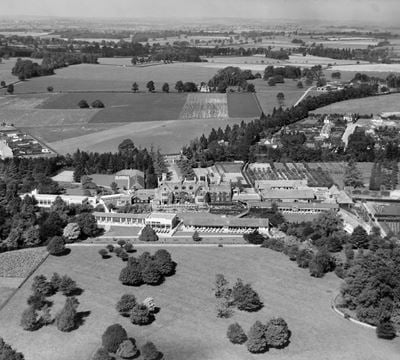
Northampton
The Manfield Orthopaedic Hospital, Northampton, 1938
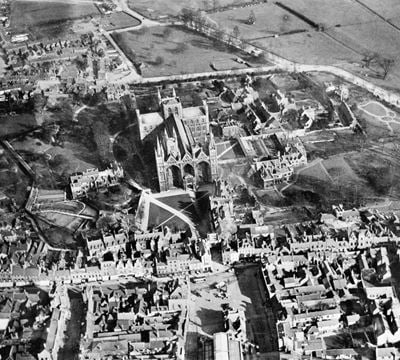
Peterborough
The Cathedral Church of St Peter, St Paul and St Andrew, Peterborough, 1924

Peterborough
Peterborough Cathedral and the surrounding area, Peterborough, 1952
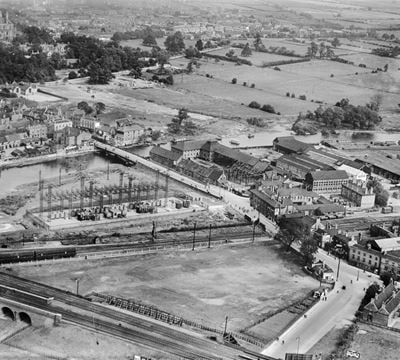
Peterborough
The English Brothers Ltd Saw Mill, the Electricity Sub Station off London Road and environs, Peterborough, 1931

Peterborough
The Peterborough Lido, Peterborough, 1947
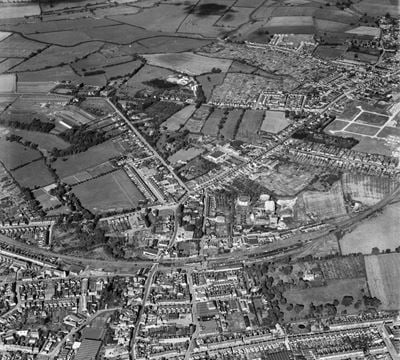
Rushden
The railway station, gas works and environs, Rushden, 1946
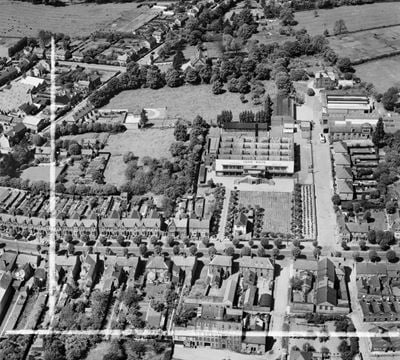
Rushden
The John White Impregnable Boots Ltd Works, Rushden, 1952
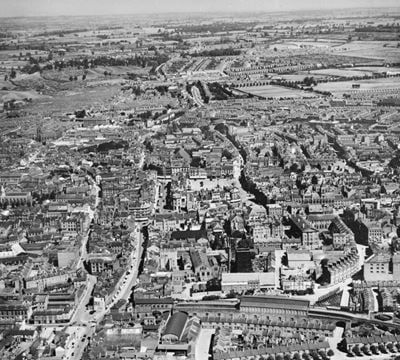
Northampton
The town, Northampton, 1934
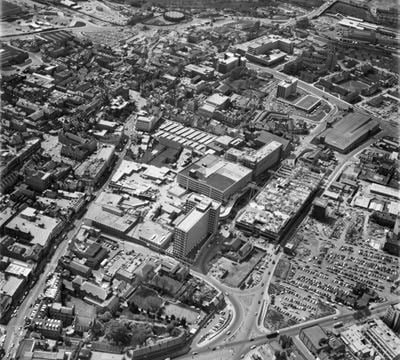
Northampton
Town centre, Northampton, 1975
Northamptonshire in the Historic England Archive
The Historic England Archive cares for over 15 million images, dating from the 1850s to the present day. Discover stunning images of Northamptonshire's past. Skip this section and go to stories about heritage
Charles George Harper Collection
South Northamptonshire, Northamptonshire
Date created: 1892 - 1933
A view from the south-east of Sulgrave Manor
Eric de Mare
Aynho Village, South Northamptonshire, Northamptonshire
Date created: 1945 - 1980
General view of Aynho showing houses.
John Gay Collection: Miscellaneous
Daventry, Northamptonshire
Date created: 1946 - 1999
St Nicholas's Church viewed from the east showing the mound beneath the east window containing the Cave family vault
John Gay Collection: Counties
South Northamptonshire, Northamptonshire
Date created: 1950s - 1960s
View looking south along a snow covered High Street in Brackley, showing a boy riding a bicycle in the foreground
John Laing Collection
Northamptonshire
Date created: 05 Jul 1990
Mr B and Mrs P Churcher toasting a drink to celebrate their golden wedding anniversary at their home in Northamptonshire
London, Midland and Scottish Railway Company
Northampton, Northamptonshire
Date created: 23 Nov 1927
A view showing two men standing in the loading bay of S.P.D. Limited at Bridge Street Station, Northampton
Alfred Newton and Sons
South Northamptonshire, Northamptonshire
Date created: 1896 - 1920
EXTERIOR VIEW OF ST PETER AND ST PAUL CHURCH, CHACOMBE FROM THE SOUTH
Nigel Temple Collection of Postcards of Parks and Gardens
Kettering, Northamptonshire
Date created: 1920 - 1940
GENERAL VIEW
Walter Scott
Kettering, Northamptonshire
Date created: 1936
A view of Queen Eleanor's monumental cross in the village of Geddington
John Gay Collection: Counties
South Northamptonshire, Northamptonshire
Date created: 1950s - 1960s
View looking south along a snow covered High Street in Brackley, showing Magdalen College School in the foreground
John Laing Collection
Cosgrove, South Northamptonshire, Northamptonshire
Date created: 11 Sep 1958
Aggregate supplies being extracted from Cosgrove Quarry for the construction of the London to Yorkshire Motorway (M1)
Alfred Newton and Sons
South Northamptonshire, Northamptonshire
Date created: May 1898
EXTERIOR FROM SOUTH
Stories about heritage in your local area
Historic England publishes news, blogs, research, videos, and podcasts celebrating England's rich heritage. Discover the stories we have about Northamptonshire. Skip this section and go to education
What Is the Oldest House in England?
Mentions Prebendal Manor House
Discover when the oldest house in England was built. The earliest domestic house, Saltford Manor House, could date from the 12th century.
An Introduction to Artist Henry Moore
Mentions Church of St Matthew
From Yorkshire miner’s son to world-famous artist who revolutionised sculpture in the 20th century.
10 Historic Sites That Tell the Story of Katherine of Aragon in England
Mentions Cathedral Church of St Peter, St Paul and St Andrew
Explore the significance of places visited or lived in by Katherine of Aragon, the first wife of Henry VIII.
8 of England’s Most Beautiful Cathedrals to Visit
Mentions Cathedral Church of St Peter, St Paul and St Andrew
From Norman to Modernist, there are many different architectural styles on show in England’s cathedrals.
Anglo-Saxon Architecture: Understated Jewels of England’s Heritage
Mentions Church of All Saints
Discover the legacy of Anglo-Saxon architecture including some of England’s oldest standing buildings.
9 Stunning Country Houses You Need to Visit
Mentions Rockingham Castle
Here are nine of our favourite country houses and gardens from around the country.
5 Historic Places that Mark LGBTQ+ Love and Pride
Mentions Apethorpe Palace Formerly Known As Apethorpe Hall
Explore the historic places in England connected to LGBTQ+ history
7 Things You May Not Know About the Battle of the Somme
Mentions Former World War I National Filling Factory, Banbury
The Battle of the Somme was a joint offensive by the British and French forces.
6 Historic Sites Added to the Heritage at Risk Register
Mentions Former World War I National Filling Factory, Banbury
Our Heritage at Risk Register is an annual snapshot of the health of England’s heritage.
England’s Record Breaking Heritage
Mentions Express Lift Tower
The Guinness World Records celebrates 60 years of extraordinary achievements this week, from globetrotting explorers to sports heroes smashing records.
7 Abandoned Villages That Can Teach Us About Medieval Life
Mentions Abandoned Medieval Village of Little Oxendon, Clipston medieval settlement, Site of the medieval settlement of Kirby
Explore the spaces in which medieval people farmed and made their homes in the English landscape.
Protected Sites in England Linked to JFK
Mentions Thor missile site at former RAF Harrington
John F. Kennedy’s assassination generated shockwaves worldwide. Here are the sites associated with his work and legacy.
Gods and Goddesses, Heroes and Heroines in the Nene Valley
Mentions Northamptonshire
The discovery of an important group of Roman sculpture fragments in the Nene Valley.
Coinage and Ritual Deposition at Stanwick, Northamptonshire.
Mentions Northamptonshire
Analysis of one of the largest rural coin assemblages from Roman Britain at Stanwick, Northamptonshire sheds light on Roman ritual and economy.
Research Reports Roundup to February 2024
Mentions Northamptonshire
A roundup of new additions to the Historic England Research Reports database and a longer term overview of industrial heritage reports.
Introducing Organic Residue Analysis and Archaeology: Guidance for Good Practice
Mentions Northamptonshire
Describing the thinking behind Historic England's 2017 guide to organic residue analysis and what this technique can bring to archaeology.
Must Farm Bronze Age Timber Platform
Mentions Northamptonshire
A fresh perspective on the Bronze Age discoveries at Must Farm examining their wider settlement and landscape context.
Picturing High Streets: Over 200 Images Taken by the Public Enter Historic England Archive
Mentions Northamptonshire
Documenting a year in the life of the English high street, images taken by the public as part of 'Picturing High Streets' can be viewed online.
Research Reports Roundup August 2023
Mentions Northamptonshire
A roundup of recent research reports added to our database in June 2023 to August 2023, displayed by heritage themes.
Heritage at Risk in the Midlands Revealed
Mentions Former Weedon Barracks, Outer Walls and North East Bastion, Northamptonshire
41 sites have been saved and 32 sites added to the Heritage at Risk Register 2023 in the Midlands.
Research Reports Roundup November 2022
Mentions Northamptonshire
An overview of additions to the Historic England Research Reports database from January to November 2022.
Five New Historic England Commissioners Appointed (2022)
Mentions Northamptonshire
Nairita Chakraborty, Jane, Lady Gibson,David Laing, Sir Jonathan Marsden KCVO, FSA andRobert Sackville-West are appointed for a four-year term.
Historic England Launches New Map Revealing a Century of England From the Air
Mentions Northamptonshire
For the first time users can search and explore an online map showing aerial photographs of England over the past 100 years.
Introduction to Issue 17
Mentions Northamptonshire
Introduction to issue 17 of Historic England Research magazine: featuring an early castle, finds from a shipwreck, Roman sculpture and retrofitting.
Northamptonshire's social history through photos
Over 10,000 images from the Historic England Archive have been specially selected and re-captioned for teachers, students, and anyone who wants to learn more about their local area. Skip this section and go to grant-aided places
Yarwell Mill, Yarwell, Northamptonshire
Period: Victorian (1837 - 1901)
This watermill was built in 1839. It replaced an earlier mill shown on the enclosure map of 1778.
Yarwell Mill, Yarwell, Northamptonshire
Workers at Charwelton, Northamptonshire
Period: Victorian (1837 - 1901)
The workers at the ironstone quarry near the village have a large steam engine for power and a small makeshift hut for shelter.
Workers at Charwelton, Northamptonshire
Whipping cross, Naseby, Northamptonshire
Period: Medieval (Middle Ages) (1066 - 1484)
A view of the cross in its new position at the junction of Newlands with Haslebech and Clipston roads. It was removed from the churchyard in c1820.
Whipping cross, Naseby, Northamptonshire
Waterways Museum, Stoke Bruerne, Northamptonshire
Period: Georgian (1714 - 1836)
This building was built in the early 1800s. It was used as a warehouse.
Waterways Museum, Stoke Bruerne, Northamptonshire
Wash House, Little Brington, Northamptonshire
Period: Victorian (1837 - 1901)
This wash house is one of several. They were built as part of a group of estate cottages on the Althrop Estate.
Wash House, Little Brington, Northamptonshire
Wash House, Chapel Brampton, Northamptonshire
Period: Victorian (1837 - 1901)
This wash house is one of several. It was part of planned layout of 10 houses and accompanying wash houses.
Wash House, Chapel Brampton, Northamptonshire
Wallis's Mill, Brigstock, Northamptonshire
Period: Victorian (1837 - 1901)
This factory was built in 1873-4. It was for the clothing company Wallis and Linnells. The company began in 1856 in Kettering.
Wallis's Mill, Brigstock, Northamptonshire
Village Hall, Sulgrave, Northamptonshire
Period: Georgian (1714 - 1836)
This building was originally the village school. It has a datestone with the inscription 'H.I.M./1720'.
Village Hall, Sulgrave, Northamptonshire
Visit grant-aided places near you
These places and buildings have been helped by Historic England's financial grants. Find historic places in your neighbourhood that you never knew existed! Please note that opening times may vary. Skip this section and go to related locations
Delapre Abbey, London Road
This 900-year-old former nunnery, near Northampton Town Center, accessible via major road networks, has undergone partial restoration after being on...
Old St John's Church, Boughton
Within a medieval churchyard, you'll find the ruined remains of a Norman church with elements from the 14th and 15th centuries.
Discover more
Ready for more local heritage? Take a look at these other places nearby
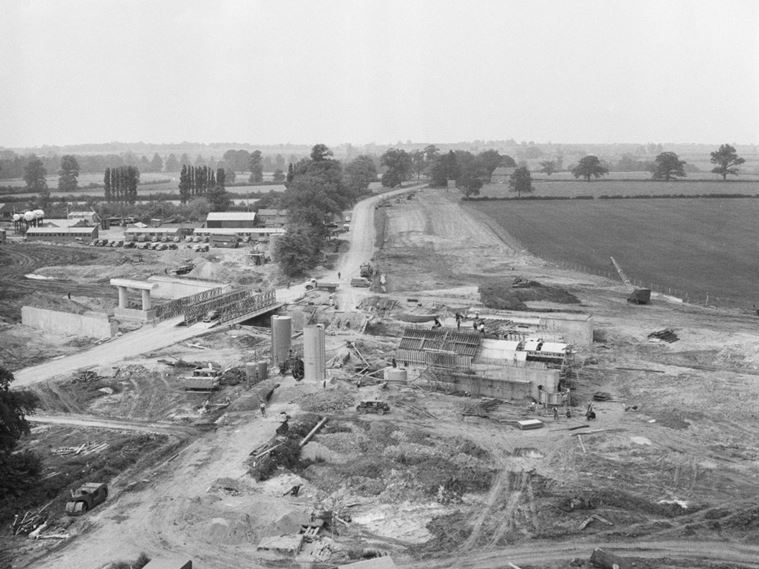
Northampton
Town
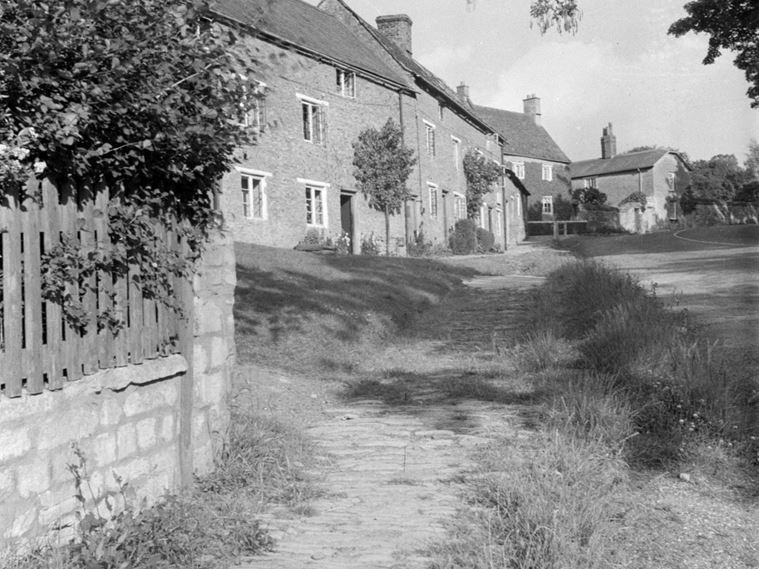
West Northamptonshire
Local Authority District

North Northamptonshire
Local Authority District